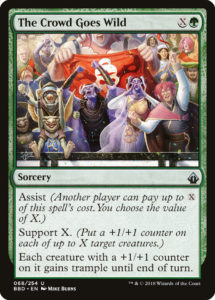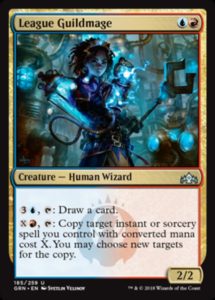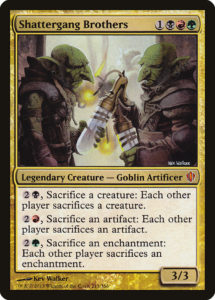In Fall of 2013, something wondrous happened: Team Draft League was born. It was a collection of New York City-based Limited grinders and aficionados who wanted to step up their game (including many Hipsters of the Coast) by playing Theros Limited at a high level. Previously, we’d been randomly team drafting in restaurants and bars, often after weeknight drafts at local game stores. TDL began an era which transformed all of us into much, much better Limited players. The League has had its ups and downs, including taking a year off, but it’s been back since Dominaria with, er, me as its commissioner.
Today, I’d like to talk about team drafting, about what a team draft league is, and why you should form one. We’ve got a lot to cover, so let’s dive right in!
What Team Draft Is
Team Drafting is, bar none, the best way to get better at Limited as a beginning or intermediate player. There are two primary ways to team draft: form teams before the draft or form them afterward.
If you have six people, you’ll probably form two teams of three players before the draft begins. You’ll sit at the draft with an opponent seated directly to your left and right, then you’ll draft as normal. (This is what you see in the Top 4 of a Team Limited Grand Prix.) After the draft, sit with your teammates away from the opposing team. You’ll build decks together and can share information about what you passed in the draft and suspect other players are doing. You can’t share any cards from your draft pool with anyone else, though. Once all decks are built, you’ll play a match against everyone on the other team. Some team drafts allow you to speak with your teammates to discuss lines of play, while others (including Team Draft League) only allow you to discuss mulligan decisions and cards you’ve seen in the draft—because discussing lines of play can make games take forever. The first team to five match wins is victorious.
If you have eight people, the most common way to team draft is to draft as normal, then form two random teams after drafting. Deckbuilding and talking rules are the same as for a six person team draft. Before playing your matches, you’ll randomly determine one player from the opposing team not to play, then each player plays three matches. First team to seven match wins, wins the whole shindig. (It’s possible to have a six-six tie.)
At the end of a team draft, the winning team keeps all cards opened. They can distribute it amongst themselves via record (usually a snake draft) or via discussion. This is the biggest turnoff for some folks, since it means you can’t rare-draft, but that’s the whole point—everyone needs to draft the best decks they can, rather than the most expensive cards they see. If you’re playing at Day Two of a Limited Grand Prix, or drafting in the Top 8 of a PPTQ, winning is more valuable than nabbing a ten dollar card. Team draft has real stakes. Of course, it’s also the cheapest way to draft with real boosters, since you can use prize packs or booster bought in bulk (rather than full retail packs) and don’t have to pay for any prize support.
Team Draft *League*
A Team Draft League is the next step in stepping up your game. Once you’ve got enough people excited about and familiar with team drafting, you can start organizing. Have everyone divide up into teams of three* and commit to those teams for an entire season. The league’s commissioner will generate a schedule—possibly using David McCoy’s fantastic league website, which I’ll talk about again later on—and every week, each team will face a team they’ve not yet played. (Ideally there’s an even number of teams, otherwise each team gets one bye week where they don’t have a match.) Once all teams have played, there’s a cut to top 4, and two weeks later, you have your champions. Our league likes to collect dues from all participating teams and then redistribute them to the top 4 teams as added stakes/incentives to play, but the glory of victory is sufficient for many.
* You can also have teams of four, but someone will have to sit out every week. This is best for teams with folks with awkward schedules or who plan to travel for an extended period during the season.
And that’s what a league is, in a nutshell. There a lot of best practices and lessons learned over the past five years, like organizing your matches the week before you’re scheduled to play, how substitutions work (you probably shouldn’t let a team substitute more than one player), how to curate your group (folks who are mean, rude, or chronically disorganized tend to dampen the experience for everyone), how to handle judge calls/rules questions, and having matches not conflict with your local game stores events. I can write several thousand words on running a league; but suffice to say, there’s a lot to learn and whole lot to gain. They’re fun, they create healthy competition and foster communities, and they get you real good at Limited real fast.
Five years of TDL
Most of my fondest Magic memories involve people from Team Draft League—traveling to tournaments together, hanging out outside of Magic, or, of course, team drafting together. I remember winning the very first season because Dylan Hiester recognized I wasn’t bluffing, but his two teammates did not. I remember Richard Tan going from a less experienced drafter who loved red-green mono-four drops in Theros Limited to one of the best players I’ve ever had the privilege of playing alongside. I remember Lirek making his first Grand Prix day two at my first GP, and how a few years later, not making day two was the exception for TDL players rather than the rule.
The league has had over a hundred members and subs in its five years of existence. We’ve had some of the best players in history in the league, but the most important people in my mind are those who helped build the league in its infancy—people like Matt Jones, Hunter Slaton, Carrie O’Hara, Jess Stirba, and David “Bones” McCoy (all of whom you might all know from this very site). I remember fondly the people who have long challenged me to step up my game, people like Hugh, Monique, Gabe, and Abe Lusk. I remember the fabulous hosts, like Kadar who usually has his adorable dachshund Frank and always had art in his studio, or James who always cooks delicious food, or Longo who lives at the intersection of everyone. I remember Ian making the worst draft pick ever (and loving that it let me analyze it), Brittany casting the best Essence Flux ever (which I wasn’t even present for, but I believe it involved an opponent’s Mirrorwing Dragon), and being able to communicate with Ryan & Abe via our Aether Revolt draft picks. And that’s just a fraction of the people I regularly interact or have interacted with in the league and deeply enjoy the company of.
To be a part of a league is to be a part of a community. A community requires care and attention, but it can be self-sustaining and self-perpetuating. It has been a privilege to participate in fourteen seasons of TDL and an honor to continue the tradition as commissioner. Guilds of Ravnica looks sweet and makes me hungry for more high level Limited with some of my best friends in Magic. I strongly encourage you to give team drafting a try, if you haven’t already.
And that’s TDL in a nutshell. And as always, thanks for reading.
—Zachary Barash
Zachary Barash is a New York City-based game designer and the commisioner. He designs for Kingdom Death: Monster, has a Game Design MFA from the NYU Game Center, and does freelance game design. When the stars align, he streams Magic.
His favorite card of the month is Syndic of Tithes. Sometimes, a simple but powerful mechanic on a simple, but serviceable is all a card needs to shine.




